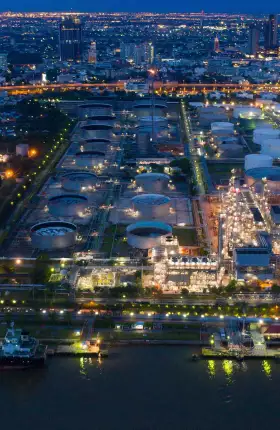Against an industry backdrop of weak demand and overcapacity, M&A is growing in importance as a key lever for chemical companies to achieve growth. But at the same time, the specific reasons for doing a deal have shifted since the industry’s heyday in the 2010s.
Whereas megadeals aimed at gaining scale or lowering costs dominated deal activity in the last decade, now companies are taking a more cautious approach and pursuing smaller, more focused transactions with the goal of optimizing their portfolios, accessing innovation, and building greater resilience and long-term competitiveness.
To maximize M&A’s potential to create value inorganically in the current challenging environment—and get deals done—players need to think creatively, anticipate market developments, and pursue transactions that differentiate them from their peers.
A Shift in Focus
This report is BCG’s fourth on M&A in the chemical industry and relies on a proprietary methodology that classifies transactions based on their strategic rationale. (See “Key Deal Drivers.”) Since our last report in late 2023, we have extended our analysis to include the period from mid-2023 to the third quarter of 2025. Our latest findings build seamlessly on those in previous reports.
Key Deal Drivers
We have classified deals based on their strategic intent as reflected in disclosed rationales, transaction structures, and changes in market positioning. This framework helps us to evaluate how companies are using M&A not only to navigate current challenges but also to reposition themselves for long-term competitiveness. For the purpose of our analysis, emerging markets are defined as Southeast Asia, South America, Africa, and the Middle East.
Since mid-2023, the total annual value of deals in the chemical industry has fallen. While annual volumes have softened slightly since the turn of the decade—and are down by a quarter since 2017—megadeals (exceeding $10 billion) have virtually disappeared due to rising financing costs, greater regulatory scrutiny, and uncertainty about the global economy. The lack of these very large deals is the primary factor behind the decline in deal value. (See Exhibit 1.)

Following a challenging period early in 2025—a result of financial market volatility and policy uncertainty—the global M&A market has steadily recovered. The trend in BCG’s M&A Sentiment Index (which measures dealmakers’ willingness to engage in mergers, acquisitions, and divestitures) has been increasingly positive across all sectors recently, with confidence particularly robust in technology and energy. In the first nine months of 2025, aggregate global deal value rose by 10% compared with the same period last year. In addition, the number of megadeals has increased, indicating growing optimism in the market.
The chemical industry stands out. While transactions over $1 billion have re-emerged, deal activity remains well below other industries and lags previous periods of strong performance in chemicals (notably between 2012 and 2016 and, to lesser extent, between 2017 and 2021). Furthermore, players are shifting their attention to deals that help reshape their portfolios around sustainability, innovation, and geography and away from other transaction types.
Fragmentation Presents an Opportunity
Regardless of deal size, the chemical industry lends itself to M&A because of the high level of fragmentation in many subsectors. Across all chemicals, the top five players together account for less than 5% of global industry revenues—which is remarkably low for an industry of this size. While significant fragmentation is the norm within many subsectors, the picture is more nuanced. In agrichemicals, for example, the top five companies control 60% of revenues, while in commodity polymers, they account for less than 10%. (See Exhibit 2.)

Such high fragmentation means that M&A remains a plausible route for chemical companies to not only increase scale but achieve growth in other ways, including through access to technology and by building dominance in key regions.
Stay ahead with BCG insights on M&A, transactions, and PMI
Emerging Deal Rationales
While all seven rationales continue to play a part in chemical industry M&A, their relative importance has shifted since 2022 compared with previous periods. (See Exhibit 3.) The importance of subsector consolidation—although still a key deal driver—has diminished significantly since its high point between 2012 and 2016. Vertical integration (where a company acquires another to gain greater control of the value chain) has also become relatively less important, suggesting that the bulk of the deal activity related to this rationale has taken place.

However, as chemical companies have increasingly focused on smaller, more specialized acquisitions and growth opportunities in adjacent markets, portfolio optimization and diversification and technology and innovation have gained in importance as deal rationales. Financial investment remains an important deal driver, indicating the continued strong participation of private equity firms in the sector. Geographic expansion has also grown in relative importance in the latest period. This is largely due to outbound M&A transactions by Middle Eastern and Asian companies seeking technological capabilities and access to downstream assets and markets in other geographical regions.
The following provides a deep dive into how these seven deal rationales have played out since 2022, along with key examples.
Subsector consolidation
Among subsectors with high fragmentation—such as construction chemicals and CASE chemicals (coatings, adhesives, sealants, elastomers)—consolidation remains an important dealmaking rationale. Such deals are generally intended to achieve economies of scale, improve pricing power, or secure market leadership. For example, Sika’s $6.2 billion acquisition of MBCC Group in 2023 significantly expanded its position in the construction chemicals market, making it a leading global player.
Consolidation has also been a recent key driver of deal activity in methanol production. Methanex’s purchase of OCI Global’s international methanol division for $2.05 billion in mid-2025 enabled the expanded business to achieve global scale and valuable operational synergies by bringing together two major players in methanol production.
Portfolio optimization and diversification
Several large chemical companies have used targeted deals to streamline their portfolios to concentrate on high-growth areas—such as medical polymers, health and nutrition, and sustainable personal care—or to exit unprofitable subsectors. In February 2025, DSM-Firmenich sold its stake in the Feed Enzymes Alliance, an animal feed business, to its partner, Novonesis, for $1.6 billion, sharpening its focus on core life sciences. And in 2023, Solvay spun off its specialty chemical division into a new listed business so that it could concentrate on essential chemistry areas.
In a sign of the region’s declining competitiveness in petrochemicals, LyondellBasell agreed in mid-2025 to sell four European petrochemical plants to Aequita, a private equity firm, enabling the company to cut costs and reduce capex. Meanwhile, Dow Chemical plans to shut down three European upstream petrochemical assets by 2027.
Financial investment
Private equity has become a significant force for transformation in the chemical industry through M&A. Over several years during the last decade, it has accounted for around one-third of total deal volumes. (See Exhibit 4.) Private equity players typically target underperforming businesses in subsectors with high fragmentation, strong margins, and consolidation potential—such as chemical distribution, polymers, adhesives, and personal care—and use buyouts, carve-outs, joint ventures, and public-to-private deals to create value. Recent deals that illustrate this trend include Cinven’s acquisition of MBCC Group’s Admixtures business from Sika, Dupont’s sale of a controlling stake in Delrin to TJC, and Bain Capital’s acquisition of Tanabe Pharma from Japan’s Mitsubishi Chemical Group.

Ownership structures have evolved since the start of the decade and are now more versatile. One example is the joint venture, Envalior, established by German chemical company Lanxess and private equity player Advent International in 2023 to buy DSM’s materials business. (Lanxess has subsequently announced it will sell some of its minority stake in the venture to Advent.) Similarly, BASF recently agreed to sell a majority stake in its automotive OEM coatings business to Carlyle, a private equity firm, and the Qatar Investment Authority.
New financial players have entered the market. These include Macquarie Asset Management, which has partnered with Dow Chemical to provide infrastructure services—including power, steam, and environmental operations—at Dow plants in the US. In addition, while North America remains the most active region for PE players, Asia has grown in importance and today is challenging Europe’s position as the second most active region.
Technology acquisition
Chemical companies are pursuing assets that give them access to innovative technologies. Leading areas of interest include battery materials for electric vehicles, chemicals that are essential for the hydrogen economy, bio-based agricultural inputs, and circular packaging chemicals. For example, DuPont acquired Spectrum Plastics Group, a manufacturer of medical-grade plastics, for $1.75 billion in May 2023. Similarly, Saint-Gobain purchased Fosroc International, which makes adhesives and additives, in mid-2024 for $1.03 billion.
Vertical integration
Faced with volatile input costs and supply chain disruptions, companies are integrating vertically along their supply chains to benefit from more stable margins and security of supply. In July, BASF bought out its partner in the Alsachimie joint venture to secure essential upstream feedstocks for polyamide 6.6 chemicals. Other companies have taken a creative approach to vertical integration. In August, Mitsubishi Chemical, Asahi Kasei, and Mitsui Chemicals established a partnership, Setouchi Ethylene, to optimize production capacity and shift towards using bio-based feedstocks and low-carbon fuels in their Japanese ethylene manufacturing operations.
Cross-border M&A involving emerging markets
Outbound transactions by emerging market players are increasing as buyers seek innovative technologies and access to select markets in Europe and North America. ADNOC’s €14.7 billion bid for Germany’s Covestro, a manufacturer of polymer materials, and the Abu Dhabi company’s merger of its polyolefins business with those of Austrian player OMV—both of which took place this year—are two examples of this trend. Meanwhile, transactions that give developed market players access to emerging markets continue, although they are the least significant of the seven deal rationales. UK chemical player Ineos’s $7 billion joint venture with China’s Sinopec—which included Ineos’s purchase of stakes in multiple Sinopec assets—illustrates this trend.
Where the Deal Action Is Happening Today
While the chemical industry in general is repositioning for resilience and future growth, M&A is far from uniform. Understanding the shifts in deal activity is essential for spotting where companies can create value—and where they can defend value in the face of competition from peers, regulatory actions, and shifts in access to resources.
As the deals above indicate, significant regional differences in activity exist. While acquisitions in North America and the Middle East are on the rise overall, European players are looking to divest assets, particularly in petrochemicals. Beyond individual asset sales, many European chemical companies now face the imperative of restructuring entire value chains—spanning feedstocks, energy inputs, and circular materials—to adapt to high energy costs and decarbonization pressures. The next phase of M&A must center on reconfiguring the full value chain to restore competitiveness and ensure long-term viability. Asia is also seeing substantial petrochemical divestments. In August, South Korea ordered the closure of several steam crackers as part of an industry restructuring. In addition, China plans to close older, loss-making chemical plants to reduce overcapacity as part of its “anti-involution” campaign.
At a subsector level, specialty chemicals, chemical distribution, agricultural inputs, and industrial gases are benefiting from substantial investment from M&A players. All of them offer strong margins, access to innovative technologies, and alignment with sustainability trends.
Among specialty chemicals, M&A interest is particularly strong in medical polymers, personal care, electronics materials, and construction additives, while dealmakers in agrichemicals and fertilizers are targeting biologicals, formulation enhancements, and energy-efficient production. Meanwhile, distribution in specialty chemicals is seeing a large number of PE-led deals aimed at consolidation.
Five Imperatives for Dealmakers
While deal activity in the chemical industry remains subdued, companies are increasingly viewing M&A as an engine for growth and transformation—rather than simply a means to build scale. Many deals have been put on pause as sellers hold out for high valuations, even as buyers push for a lower price in anticipation of weakening profit margins. Changes in industry regulations are also creating uncertainty and holding up transactions. Nevertheless, as end-markets start to stabilize, we expect these deals to return.
In addition, greater private equity participation should drive increased activity among chemical companies that need to restructure. Persistent overcapacity, especially in commodity chemicals, will also fuel deals focused on consolidation. We expect future deal activity to be characterized by the following approaches:
- PE-led carve-outs and spin-offs
- Innovation bolt-ons (especially in agritech, battery materials, and medical ingredients)
- Cross-border partnerships (combining R&D with regulatory compliance and market access)
- Sustainability-aligned areas (such as hydrogen, biochemicals, and sustainable polymers)
Faced with persistent margin pressures, regulatory scrutiny, and high financing costs, dealmakers need to bear the following imperatives in mind to achieve success.
Prioritize resilience and differentiation.
Companies need to move beyond simplistically classifying their portfolio assets as either core or non-core. To create winning portfolios, players should focus on resilience and differentiation.
To build resilience, they must acquire assets that secure reliable access to critical raw materials, diversify geographic and supply-chain risks, and reduce vulnerability to disruptions.
Investing in specialty segments with clear technological or commercial advantages, especially those aligned with sustainability trends and materials innovation, can help companies differentiate themselves. Current attractive segments include sustainable polymers, personal care ingredients, crop biologics, and carbon-smart materials. However, players should bear in mind that differentiation through M&A needs to serve a clear purpose, such as unlocking adjacencies or reinforcing the defensibility of a company’s existing businesses.
Keep pursuing value-driven consolidation in fragmented subsectors.
The case for scale remains strong in commodity-like subsectors with under-optimized value chains. Selective consolidation—particularly in distribution, adhesives, and construction chemicals—can help companies unlock synergies, streamline operations, and create stronger platforms for growth. With valuations lower and competition for assets more muted, it is time to act decisively and benefit from the opportunity to lock in synergies and build scale before other buyers re-enter the market and push up valuations again.
Take a creative approach to dealmaking.
In a high interest rate environment, traditional buyouts may not be the best option—or indeed feasible at all. Instead, players should explore other avenues such as joint ventures, minority stakes, asset swaps, and hybrid partnerships that balance risk, regulatory flexibility, and capital efficiency. For instance, we have seen several deals where PE firms have bought businesses from corporations and where the seller has maintained a stake to keep some “skin in the game.” This also de-risked the deal for the PE buyer. Examples include TJC-owned Arclin’s purchase of DuPont’s aramids business and Carlyle’s purchase of BASF’s coatings business.
Be disciplined with synergies and integration.
With premiums under pressure, creating value from deals depends more than ever on execution. To ensure this is first rate, companies need to create detailed pre-deal models that go beyond cost-out plans and identify opportunities for synergies through revenue growth levers, asset optimization, and supply chain alignment. Post-close, they should develop tailored integration plans that reflect the specific strategic rationale of each deal rather than relying on a one-size-fits-all approach.
Anticipate market and regulatory shifts.
Use M&A to get the right side of change—whether that’s sustainability mandates, circularity targets, feedstock disruptions, or geopolitical risk. Companies should look for acquisition opportunities that ensure they are well-placed for developments in regulations, customer expectations, and trade policies. For example, buying assets that give them exposure to clean ammonia, recycled materials, or regionalized supply chains can help players future-proof their businesses.
At a global level, deal activity looks set to return to normalized levels across most sectors in the near future, based on BCG’s M&A Sentiment Index. Plentiful investment capital, stabilizing interest rates, and improved valuation levels are all contributing factors. Whether the chemical industry follows the global trend remains to be seen. Nevertheless, M&A’s role as an engine for transformation within chemicals is growing in importance. As they look to reshape their portfolios, companies should continue to tread cautiously, anticipate market shifts, and choose deals that differentiate them from the pack.






